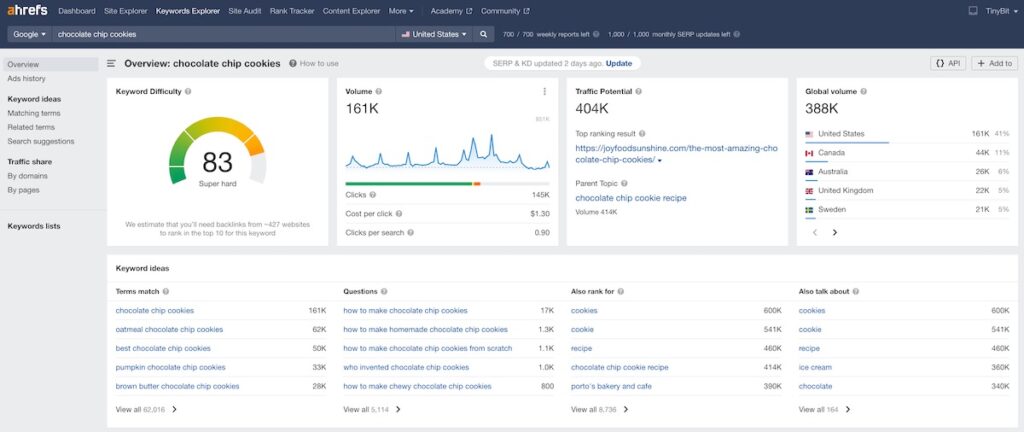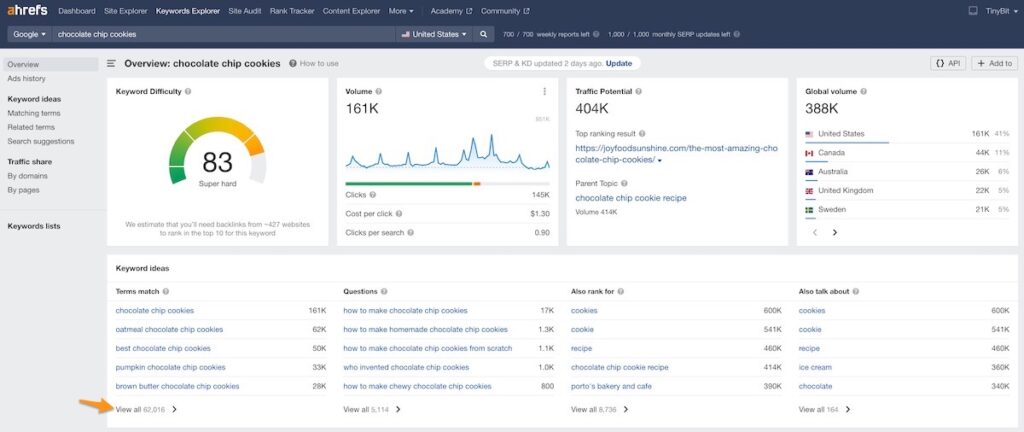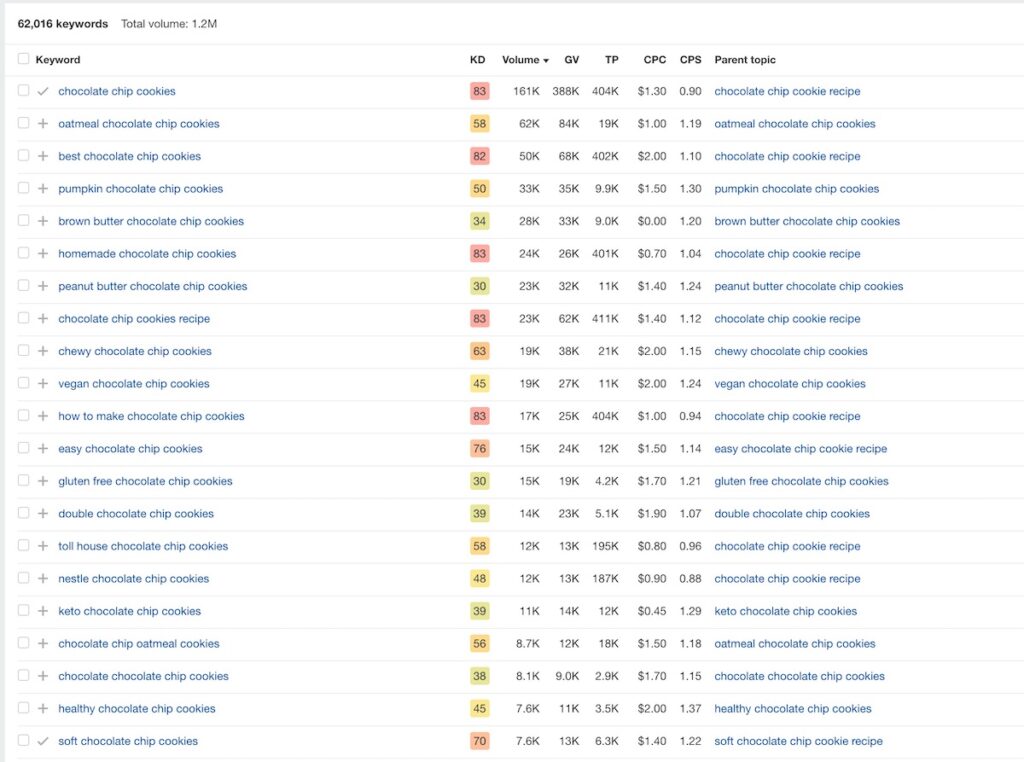Did you catch Part 1 of this two-part Keyword Research for Food Bloggers series?! If not, check out that post all about the different tools you can use for keyword research right here.
As you probably already know, everyone’s keyword research process is different, and each of those processes have quite a few steps.
So in today’s Part 2 of our Keyword Research for Food Bloggers series, we’re just focusing on 6 keyword research tips that can help you along on your keyword research journey. They’re actionable, related to recipe SEO, and good things to keep in mind whether you’re looking to start or optimize your keyword researching strategy.

We’ll cover:
- When you may want to start your keyword research
- Why we like longtail keywords
- Where you should (and shouldn’t) include your keyword
- Why keyword research isn’t the end-all, be-all
- How long it may take to see results from your keyword research
- If every post you publish should have ranking potential
Ready? Let’s dive in!
1. Start your keyword research process before you develop your recipe.
Yep, keyword research can start earlier than you may have expected.
Of course, there are going to be recipes that you want to publish that aren’t great keyword research candidates (more on that in a bit), but it helps to start researching keywords early in the recipe development process.
Why?
It can help you figure out what can make your recipe unique and even more valuable to searchers who are searching for more specific terms.
For example, if you’re wanting to develop a chocolate chip cookie recipe, you may want to start by using a keyword research tool (I’m using Ahrefs’ Keyword Explorer for this example) and search for that term:

The Keyword Difficulty is super hard, but the Volume is really high. This is saying that a lot of people are searching for this term, but it’ll be pretty difficult to rank for that keyword unless you have a ton of people linking to your site.
So a regular ol’ chocolate chip cookie recipe may not rank in the first few spots in a Google search, but are there any other related keywords we can try to rank for?
This is where we can click around under Keyword Ideas to find different iterations on this search term. If you click View All under “Terms Match,” you’ll see other keywords that include “chocolate chip cookies” along with other terms.

The search volume goes down, but the keyword difficulty (the KD column with all of the colors!) also tends to goes down.

Of course we have some variation here due to the fact that there’s a lot of content about certain keywords (for example, in the image above “how to make chocolate chip cookies” has the same keyword difficulty as “chocolate chip cookies,” even though the search volume is wildly different), but in general, when less people are searching for a keyword, the easier it will be rank for that keyword.
Ideally, you want to target a keyword that has high volume (aka there are a lot of people searching for it) and a lower keyword difficulty (aka the tool you’re using thinks it would be easier for someone to rank for that term/there aren’t many good results for that term).
Keep in mind that other tools may have their own terms for Keyword Difficulty (for instance, it’s called Score in KeySearch), but it’s still a helpful data point to keep an eye on.
And those keyword variations we found? That’s our next tip!
2. Lean into the power of the longtail keyword.
A longtail keyword utilizes those extra terms (also known as modifiers) to form a keyword that has less search volume but is also less competitive.
An example is “one bowl vegan chocolate chip cookies.” As you can probably imagine, the keyword “chocolate chip cookies” is incredibly difficult to rank for. It’s highly competitive and has a lot of search results (121,000,000 on Google at the time this article was written!), and it would take considerable effort and SEO power to rank within the first few search results for that keyword.
So instead of trying to write a post that targets the “chocolate chip cookie” keyword, we can use extra terms (or a longtail keyword) to help us reach searchers who are more likely to click on our blog post in a search result.
Not only is vegan a modifier, “one bowl” is too. By making “one bowl vegan chocolate chip cookies” your target keyword, you’re targeting searchers who are searching for a more specific need than just chocolate chip cookies. Therefore, you’re fulfilling their needs (the recipe) and satisfying their intent (wanting to find a one bowl vegan chocolate chip cookie recipe).
And as you can probably imagine, this is why it’s helpful to start keyword researching before the recipe development starts! That way, you can let these modifications help inform the recipe development process.
3. Know where to include your keyword in your blog post (and where not to).
There isn’t a way to tell Google “hey this is the keyword I’m trying to rank for, so please rank this blog post accordingly.” At least, not directly.
Instead, your strategic use of a keyword within a blog post can tell search engines what your post is about and what types of searches this blog post helps satisfy. Search engines are always looking for content that will help satisfy user intent, meaning articles and posts that get the searcher the information they’re looking for as quickly and thoroughly as possible.
So where should you include your keyword? In general, you’ll want to make sure your keyword is in:
- Your post title
- Your recipe title
- The first paragraph
- Image file names
- Your meta description
- Other parts of your post where it fits naturally
If you use your keyword too often throughout your post in an unnatural way, you’ll be at risk for keyword stuffing, which is a common form of “spam” search engines like Google keep an eye out for. If you’re looking for a rule of thumb about how often you should use your keyword, we’ve heard that a 2% keyword density, meaning your keyword makes up only 2% or less of your content, is a solid percentage. You can measure your keyword density with tools like SEO Quake or Semrush.

That said, as long as your post sounds natural and you’re not throwing keywords into your post just to add them, you should be a-okay. You don’t need your keyword in every heading or every paragraph –– include it where it makes sense, and leave it at that.
And do you need to type your keyword in the exact word order each and every time? No, especially if it sounds awkward or unnatural. Search engines like Google can read and understand keywords in any order and understand your intent. For example, some variations in word order for our “one bowl vegan chocolate chip cookies” keyword could be:
- Vegan chocolate chip cookies
- Chocolate chip vegan cookies
- One bowl vegan cookies
You don’t need to use the exact “one bowl vegan chocolate chip cookies” phrase over and over in your post. Write in a natural, helpful way, and search engines will understand.
4. Keyword research is just one small part of the greater SEO equation.
The goal of keyword research is to find keywords that you can target that will:
- Bring organic search traffic to your site.
- Not be too terribly difficult to rank for.
Google’s ranking algorithm is made up of hundreds of different factors, so keyword research is just a small portion of what can affect how your post gets found via search.
This article from Ahrefs does a good job at describing some of what we do know about Google’s ranking factors. Some of the most well-known ranking factors include:
- Backlinks
- Freshness (or recency)
- Keyword mentions
- User experience
- Topical authority
So just keep this in mind as you’re doing your keyword research –– it’s just one part of the very large SEO equation!
P.S. Want to learn more about SEO?P.S. Depending on the tools you use for keyword research, you may come upon information about your domain authority, authority score, or domain rating.
These metrics are developed by companies like Moz, Ahrefs, and Semrush and are not ranking factors in the eyes of Google. It’s a nice metric to see and understand, but it’s not used in determining your post ranks in search results. You can find more information about this metric here!
5. It may take some time to see results from your keyword research.
How long your blog has been around, how old the post is, and how many other websites have linked to your content can all impact the length of time it may take to see results from your keyword research. That means that it’s possible that, for new content, it may take days or months to actually see significant organic search traffic numbers for that post.
Since it takes time, try setting yourself up for that eventual success by making your post as well-researched and thorough as possible. Some things to keep in mind are:
- Add some related internal links to that blog post
- Add links back to the blog post you’re optimizing in some of your existing related blog posts
- Make sure your image names and alt text are descriptive
- Make sure your images are the correct size
- Keep quality guidelines like E-E-A-T (Experience, Expertise, Authoritativeness, Trustworthiness) in mind to help make your post as helpful as possible
- Fill out all recipe plugin fields
- Help your readers easily navigate your blog post and get to the answers they want faster with a “Jump to Recipe” button, FAQs, and a table of contents
By focusing on those other SEO elements and by making sure that your post is as comprehensive and helpful as possible, it may help move that ranking needle even quicker!
6. Not all posts will have keyword ranking potential… and that’s okay.
All of this being said, if you have an incredible recipe for a regular ol’ chocolate chip cookie, does it mean you shouldn’t post it if you don’t think you can rank for it?
Of course not! If it’s still content that your readers, email subscribers, and/or social media followers will love, it’s still great content. Just because it may not rank in the first few positions in a search result, your content can still be helpful and fulfill a need for your readers, and it can still drive traffic back to your blog through other avenues like social media or email.
In fact, for most bloggers, the majority of their search traffic comes from just a handful of posts –– not all posts are organic search super stars.
Plus, as your blog grows, your keyword volume and ease at which you can rank for keywords can grow. And you can always go back to posts you’ve done keyword research for 6-12 months later and tweak as needed.
That’s why it’s so important to write for your readers and not for what you may think search engines want –– Google isn’t reading, using, and sharing your posts; humans are. 😊
And that’s a wrap on this two-part series all about keyword research! Here are some other resources you might want to check out to dive even further into keyword research fun:
- 362: How to Increase Your Organic Traffic with Keyword Research with Aleka Shunk
- 405: How Keyword Research, Resilience, and Resourcefulness Helped Casey Rooney Make a Six-Figure Income in Two Years
- Juicing the Low-Hanging Fruit: Optimizing Old Content for SEO
- 7 Mistakes Food Bloggers Make When Writing Recipes
What other keyword research questions do you have? Leave them in the comments below, or add them to the queue of our upcoming member-only Q&A with our Keyword Research Expert, Aleka!
Does the Ahref tool you showed have a free version?
Hi Marcel – yes and no! More info on that here.
I loved the keyword research tips, can I apply these tips to any niche if I adapt?
Thank you, Julia! And yes, absolutely – these tips should be fairly universal.
I appreciate the effort you put into providing valuable resources and recommendations to your readers.
Thanks for reading!
For the recipe card, I see to fill out all sections–should we even fill out sections we don’t feel are applicable? For example, the recipe cost (it would be a complete guess with all the pantry staples), or the custom time label if we don’t feel there’s an additional time to note? Inline/associated ingredients? Or what about if a recipe is pretty straight forward and doesn’t need additional notes at the bottom? Thanks!
Hi Holly! Great question. Sometimes it doesn’t make sense to fill out every section of a recipe card (like you mentioned) or it might be an intentional choice to leave a section blank (for example, some bloggers choose not to include nutrition information), but in general, you should fill out all fields that are applicable and available in a recipe plugin.
The more sections you can fill out the better, but don’t fill out just for the sake of filling out or make something up just to fill in a blank (if that makes sense)!
More from Google on why this matters here! https://developers.google.com/search/docs/appearance/structured-data/recipe#recipe_properties
Google isn’t reading, using, and sharing your posts; humans are. That is great indeed!
Words to live by! Thanks so much for reading.
This article is so helpful! I feel more confident about my keyword research now.
Hi Aaron – happy to hear that!